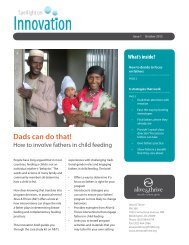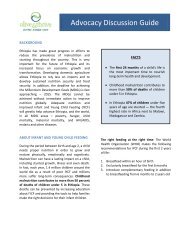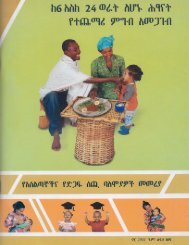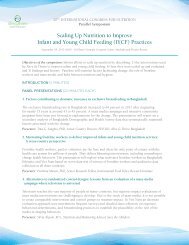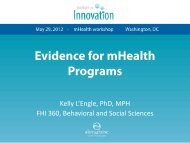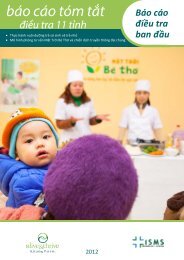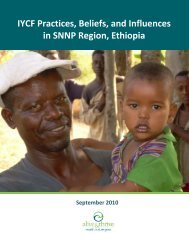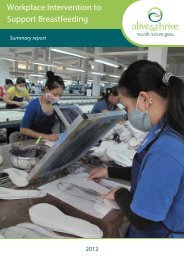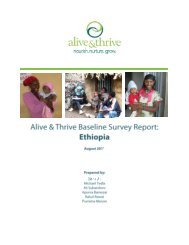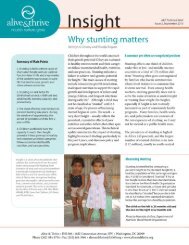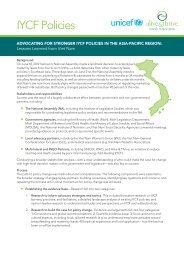IYCF Practices, Beliefs, and Influences in Tigray ... - Alive & Thrive
IYCF Practices, Beliefs, and Influences in Tigray ... - Alive & Thrive
IYCF Practices, Beliefs, and Influences in Tigray ... - Alive & Thrive
Create successful ePaper yourself
Turn your PDF publications into a flip-book with our unique Google optimized e-Paper software.
3. Methodology<br />
3.1 Study area<br />
The formative research was conducted <strong>in</strong> three zones of <strong>Tigray</strong> Region: central, eastern, <strong>and</strong> southern<br />
zones with one community selected <strong>in</strong> each zone. Research communities were <strong>in</strong> Tahitay Maichew,<br />
Hawizen, <strong>and</strong> Raya Azebo. The three locations were chosen to capture differences <strong>in</strong> breastfeed<strong>in</strong>g <strong>and</strong><br />
complementary feed<strong>in</strong>g practices with<strong>in</strong> the region. Accord<strong>in</strong>g to the 2007 census result, the population<br />
is reported to be 99,184, 118,648, <strong>and</strong> 136,039 for Tahitay Macho, Hawizen, <strong>and</strong> Raya Azebo<br />
respectively. The food source for many of the households <strong>in</strong> the districts is farm<strong>in</strong>g <strong>and</strong>, from <strong>in</strong>formal<br />
<strong>in</strong>formation obta<strong>in</strong>ed from district officials, the three districts for this research are known to be food<br />
<strong>in</strong>secure.<br />
3.2 Sampl<strong>in</strong>g techniques<br />
Site Selection: Communities were purposefully selected by the A&T program team to capture vary<strong>in</strong>g<br />
factors, such as staple food, access to market, women’s employment patterns, <strong>and</strong> tribal <strong>and</strong> language<br />
composition. All of the study areas are currently served by a government health extension program <strong>and</strong><br />
are with<strong>in</strong> the current IFHP program areas.<br />
Selection of Respondents: Prior to any data collection, discussions held at Woreda Health Offices<br />
assisted the program team <strong>in</strong> ga<strong>in</strong><strong>in</strong>g permission to enter sample communities. Respondents were<br />
r<strong>and</strong>omly selected <strong>in</strong> each area from a list provided by the health post, <strong>and</strong> the study <strong>in</strong>terviewers also<br />
went door to door to identify households with children <strong>in</strong> the required age group. S<strong>in</strong>ce there was no<br />
better method to get a list of children under 2 years of age <strong>in</strong> selected communities, the health post<br />
immunization registry book was used to select participants. Selection was based on the age of the child<br />
<strong>and</strong> the will<strong>in</strong>gness of the family to be observed.<br />
Maternal <strong>in</strong>terviews <strong>and</strong> observations: Household visits were conducted when the majority of<br />
residents were expected to be home. Observations were also conducted <strong>in</strong> the same households where<br />
mothers of the eligible children were <strong>in</strong>terviewed.<br />
Focus group discussions: Focus group discussions (FGDs) were held with fathers <strong>and</strong> gr<strong>and</strong>mothers<br />
or mothers-<strong>in</strong>-law. Respondents for focus groups were selected from the same village where the women<br />
<strong>in</strong>terviewees were resid<strong>in</strong>g. Only one member of the household was selected, <strong>in</strong> order to avoid mutual<br />
<strong>in</strong>fluences <strong>in</strong> the responses. Focus group discussions were also held with village leaders <strong>and</strong> women’s<br />
group leaders. These participants were identified by village leadership <strong>and</strong> HEWs.<br />
Interviews with service providers: Interviews were also conducted with HEWs <strong>and</strong> VCHPs, as they<br />
are the <strong>in</strong>dividuals provid<strong>in</strong>g advice to mothers on child feed<strong>in</strong>g <strong>and</strong> treatment of illness. The two<br />
HEWs serv<strong>in</strong>g each of the respective study communities were <strong>in</strong>terviewed; <strong>in</strong> addition three more<br />
HEWs were <strong>in</strong>terviewed from neighbor<strong>in</strong>g communities. The overall study design used for this<br />
formative research is presented <strong>in</strong> Table 1.<br />
6



